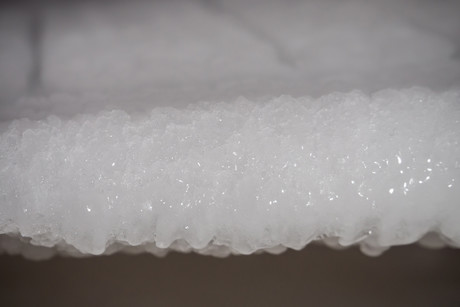Would passive anti-frosting work in the food industry?

A team of Virginia Tech has developed an anti-frosting technology that needs no chemicals or energy inputs to keep surfaces 90% free of frost.
The team was looking at frost on windshields, aircraft wings and the like but, as ice build-up causes problems in food industry freezers and refrigeration systems, you have to wonder if the technology can be adapted to keeping the food industry frost-free as well.
Traditional approaches to fighting frost have relied on the application of antifreeze chemicals or energy inputs, like heat or special coatings for surfaces that prevent frost formation. The VT technology, however, relies on the creation of a passive anti-frosting surface. So far the researchers have established a proof of concept for keeping surfaces 90% dry and frost-free indefinitely — all without any chemicals or energy inputs.
Using a simple approach to design, the researchers created their anti-frosting surface on untreated aluminium by patterning ice stripes onto a microscopic array of elevated grooves. The microscopic grooves act as sacrificial areas, where stripes of intentional ice form and create low-pressure zones. These low-pressure areas pull nearby moisture from the air onto the nearest ice stripe, keeping the overlapping intermediate areas free of frost, even in humid, sub-freezing conditions.
These sacrificial ice stripes make up only 10% of the material’s surface area, leaving the remaining 90% completely dry.
Jonathan Boreyko, an assistant professor in the Department of Biomedical Engineering and Mechanics explained, “The real power of this concept is that the ice stripes themselves are the chemistry, which means the material we use is irrelevant. As long as you have that proper pattern of sacrificial ice, the material you use could be virtually anything. So there are a lot of possibilities.”
The researchers see immediate applications for the technology in the HVAC industry, where the outdoor components of heat exchangers (like heat pumps and fan systems) already utilise a pattern of micro-fins on their surfaces. Manufacturers would just need to apply the right pattern of grooves on those fins to keep frost from building up inside the systems.
Boreyko said one of the study’s most important contributions has been the development of a rational model for how much chemical (in this case, the chemical is ice) to apply in order to keep a surface dry.
“We’ve known the trick for centuries,” he said. “You put down a low-pressure chemical, like salt, and it keeps everything else around it pretty dry. But now we’re making that effect everlasting, and we’re making its distribution rational.”
This research was partially funded by the National Science Foundation and the 3M Company.
Large-scale mixing plant for flavour production
GEA is building a new large-scale mixing plant to increase capacity of flavour ingredients...
Pure Dairy opens manufacturing plant in Dandenong South
Pure Dairy has opened its new 13,000 m2 dairy manufacturing facility in...
Manufacturing most impacted by ransomware in Q1 2025
Industrial ransomware incidents are on the rise — with food and beverage manufacturing...











